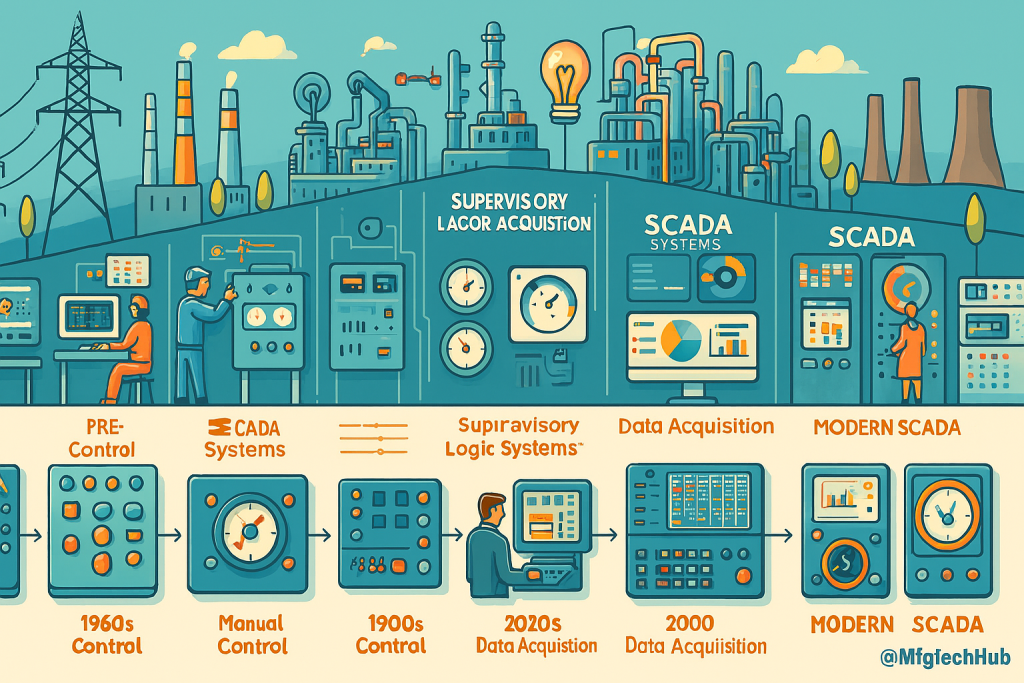Evolution and History of SCADA Systems
Supervisory Control and Data Acquisition (SCADA) systems have evolved significantly over the decades, transitioning from simple mechanical control systems to sophisticated, interconnected digital platforms. Understanding the history of SCADA helps us appreciate its advancements and role in modern industries.
This evolution mirrors broader technological progress in computing, networking, and automation, as each new industrial era brought faster, more efficient, and more secure SCADA capabilities. Over time, SCADA has not only improved operational control but also transformed decision-making, enabling industries to react faster and with greater precision.

Early Industrial Automation (Pre-SCADA Era)
Before SCADA, industrial processes relied on manual monitoring and control. Operators physically checked gauges, adjusted valves, and managed processes based on visual inspections. The key challenges were:
- Limited monitoring range – Operators could only manage systems within physical reach.
- Delayed response times – Manual operations led to inefficiencies and slow reactions to faults.
- High labor costs – Continuous supervision required a large workforce.
Industries such as oil refineries, water treatment plants, and manufacturing facilities depended heavily on human operators for every step, making operations prone to human error and costly delays. In remote locations, physical monitoring meant hours or even days before issues were detected.
The Introduction of Relay-Based Control Systems
In the early 20th century, industries adopted relay logic and hardwired control systems to automate some processes. These systems:
- Used electromechanical relays to control operations.
- Allowed basic automation but required extensive wiring.
- Were difficult to modify and troubleshoot.
Although more efficient than purely manual systems, relay logic still lacked flexibility. Any change in process design required rewiring, which could take days or weeks, limiting adaptability in fast-changing industrial environments. Maintenance teams had to physically trace wires to identify faults, leading to costly downtime.
The Birth of Programmable Logic Controllers (PLCs)
In the 1960s, the invention of PLCs revolutionized industrial control. PLCs replaced relay-based systems with software-driven automation, offering:
- More flexibility and easier reprogramming.
- Faster response times and improved efficiency.
- Integration with sensors and field devices.
Automotive manufacturing was one of the earliest adopters of PLCs, enabling assembly lines to be reconfigured quickly for different vehicle models without major electrical rewiring. This innovation also set the stage for SCADA integration, where PLCs became the primary field devices feeding real-time data to centralized systems.
The Emergence of SCADA (1960s - 1970s)
With the expansion of industries, there was a growing need for centralized monitoring and control. Early SCADA systems were introduced, which:
- Enabled remote monitoring of multiple industrial processes.
- Used modems and dedicated phone lines for communication.
- Relied on mainframe computers for data processing.
However, these first-generation SCADA systems were limited by high costs, proprietary hardware, and isolated operations.
Utilities and oil companies were among the first to benefit from these early SCADA systems, using them to monitor pipelines, power distribution networks, and water systems from a central location.
Advancements in SCADA (1980s - 1990s)
The development of personal computers (PCs), local area networks (LANs), and improved communication protocols led to significant improvements in SCADA technology:
- Graphical User Interfaces (GUIs): Introduction of HMI (Human-Machine Interface) for better visualization.
- Open Architecture: SCADA systems became more flexible, supporting third-party devices.
- Standardized Communication Protocols: Adoption of Modbus, DNP3, and OPC improved device interoperability.
These advancements made SCADA more accessible to mid-sized industries, and the visual nature of HMIs reduced operator training time while improving situational awareness. With open protocols, plants could integrate SCADA with MES and ERP systems, bridging operational and business data flows.
The Internet and SCADA (2000s - Present)
With the rise of internet connectivity, cloud computing, and cybersecurity, SCADA systems evolved into modern, networked solutions:
- Web-Based SCADA: Operators can monitor and control processes remotely.
- Integration with IoT and AI: Smart sensors provide real-time data analytics for better decision-making.
- Enhanced Cybersecurity: Stronger encryption and security measures protect SCADA networks from cyber threats.
- Edge Computing: Data processing happens closer to the source, reducing latency and improving system efficiency.
Today’s SCADA systems often run on virtualized environments, support mobile access, and can integrate seamlessly with ERP and MES platforms, making them core enablers of Industry 4.0. Industries like renewable energy, pharmaceuticals, and smart cities rely on SCADA for real-time visibility, operational efficiency, and compliance monitoring.
Future of SCADA Systems
SCADA continues to evolve, embracing new technologies such as:
- Cloud SCADA: Centralized, scalable, and accessible from anywhere.
- Artificial Intelligence (AI): Predictive analytics for preventive maintenance.
- 5G and IoT Integration: Faster, more connected industrial automation.
- Cybersecurity Enhancements: Advanced protection against cyber threats.
We can expect SCADA systems of the future to be more autonomous, self-healing, and integrated with AI-driven decision-making, allowing them to predict failures, automatically adjust operations, and optimize energy consumption in real time. Combined with digital twin technology, future SCADA platforms will simulate and test process changes virtually before deployment, reducing risks and downtime.
From manual control to fully automated digital systems, SCADA has transformed industrial operations, making them more efficient, reliable, and data-driven. As industries move towards Industry 4.0, SCADA will continue to play a crucial role in optimizing processes and enabling smart automation.
Its journey from basic relay logic to cloud-enabled predictive platforms is a testament to how technological innovation drives operational excellence across every industrial sector, and its future promises even more integration, intelligence, and impact.
